Our story for change
To ensure the visitor industry in Aotearoa New Zealand thrives, we must plan and act as one integrated industry. We must understand the industry as a system and see it as part of the whole of Aotearoa New Zealand to grasp the full potential it can contribute.
On this page
The Taskforce has identified 5 Future States which describe the ideal future and will, if pursued together, achieve the future we want. The pursuit of these Future States frames our recommendations for change. The recommendations are set out in more detail later in the report and this section briefly describes the story of change we are envisioning.
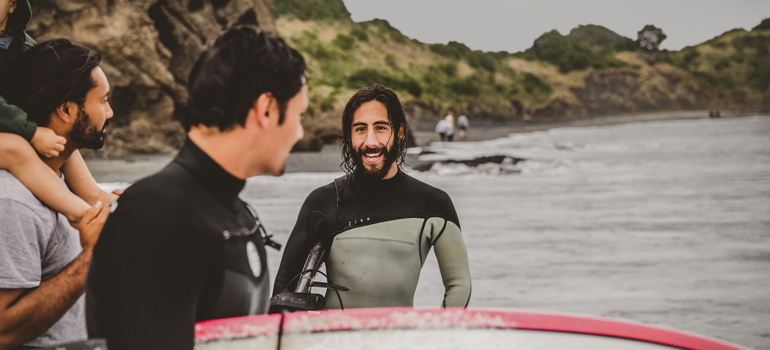
Legislative framework
The visitor industry needs dedicated and intentional legislation. Currently, much of the industry is largely unregulated and is managed through disparate pieces of legislation that were not designed with the peculiarities of tourism in mind. We have a Minister of Tourism with no legislative levers to manage industry settings. Dedicated legislation would create a framework for long-term change while ensuring the visitor industry system can endure through economic and political cycles. We are contemplating a change that will occur over many years and we need to embed core principles and practices now.
Alongside dedicated legislation for the visitor industry, we need to modernise the Conservation Act. We have identified multiple aspects of the existing legislation which currently hinder a balanced and integrated approach to achieving social, cultural, environmental and economic wellbeing. Among others, pricing control, concession management and public/private partnerships are obvious areas that can enable a balanced approach across the four wellbeings for the benefit of New Zealanders and our international visitors. We can also embed Te Tiriti principles more holistically, recognising the benefits that will flow from co-governance and iwi managing more of the conservation lands and waters, to reconnect mana whenua with the whenua. The connection between modernised conservation legislation and new dedicated legislation governing tourism will be pivotal.
Communities at the centre
Communities sit at the centre of the visitor industry, and visitors sit at the heart of our communities. To thrive sustainably, the future visitor economy needs to be led by local communities.
Our recommendations address the engagement, planning and funding mechanisms required to ensure that communities are equipped with what they need to allow the visitor economy to strengthen their local identity, connect them better to their place and drive long-term wellbeing. This is where a regenerative tourism industry begins.
By embracing the concept of Manaakitanga – care and consideration for those around us – we become a more connected, collaborative and richer society of hosts and visitors.
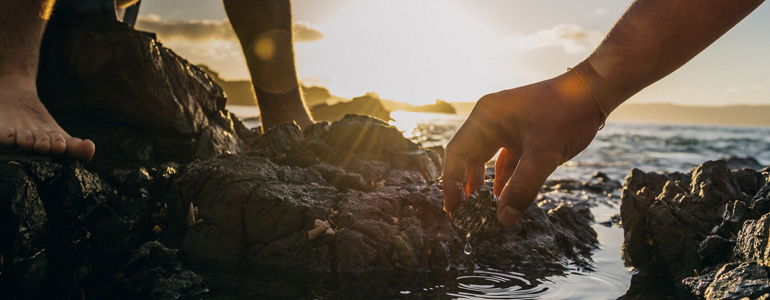
Underpinned by a Te Ao Māori approach
When we have a community-led visitor economy, we will see the essence of Aotearoa New Zealand come to life in ways that continually celebrate and enrich our unique culture. The Future State of Aotearoa Whakapapa summarises this transition and reflects the truth that our ultimate unique proposition globally is our people and our culture. At the heart of that lies an intergenerational approach of Te Ao Māori.
As the Taskforce grappled with what an authentic approach to delivering the four facets of wellbeing entailed, we found there is no better way to explain it than the Māori concept of Mauri – the life force and essence present in all things. Our recommendation is for this concept to be embedded in all aspects of the visitor economy – to enhance the health, wellbeing and life force of our society, our culture, our environment and our economy. Aotearoa Whakapapa is not just about where we have come from, our history and stories, it is also about what others bring to it. By embracing the Māori concept of Whanaungatanga – genuine connection and kinship – throughout our communities, our visitors will contribute valuably to our whakapapa over time, creating a virtuous cycle.
Caring for Te Taiao – Our environment
The Taskforce is very aware of the expectation that our recommendations should address environmental issues arising from the visitor industry. We have made recommendations in this area which will create systemic industry change. The visitor industry needs to link up with the many existing broader goals and initiatives already underway across Aotearoa New Zealand locally and nationally, like predator free, clean waterways, climate change adaptation and greenhouse gas emissions reduction initiatives.
The Tiaki Promise must underpin the visitor economy. This is a powerful and uniquely New Zealand programme that has been undervalued and underused. We need to embed Tiaki to guide everything we do domestically and internationally. The Tiaki Promise should be co-owned by the Government and private sector. It can become the internal representation for how we make 100% Pure New Zealand come alive behaviourally and operationally.
By embracing the concept of Kaitiakitanga – our role as caretakers and nurturers of Te Taiao – we will play a leading part in ensuring a healthy planet for future generations.
Industry standards

To complement the social, cultural and environmentally focused recommendations, we need a standards framework for the visitor industry. We have never had one of real depth and meaning before. All the changes we propose have to be based on an incentives and sanctions approach which will reinforce the commitment to drive progress on all 4 facets of wellbeing. Ultimately, the standards framework will need to be legislated. In the interim, benefits provided to the industry must be linked to businesses committing to and progressing their performance against these standards. The Future-Fit Business Benchmark is one example of a holistic and rounded progress measurement system for businesses that can be drawn upon.
These standards will need to address the way people are treated and cared for within the industry. This will help ensure that universally accepted minimum levels are created across a full range of employment conditions.
Business performance
The issues of infrastructure, funding and business performance are all intrinsically linked. We need to enable the Government to receive more income, distribute that more locally and enable businesses to generate more income that can be reinvested to achieve social, cultural and environmental wellbeing.
In determining a system-based solution, we need to start by understanding the supply side of visitor economy services, which includes the availability of licences, leases, concessions and other rights of access to the industry. Currently, there appears to be no comprehensive record or management of access rights. Typically, one only needs to fill in a few forms to be a tourism operator in many parts of the industry. We can’t achieve what we desire in terms of holistic wellbeing and value creation with multiple operators travelling the same routes at half-full capacity. It is both wasteful and inefficient.
There are many examples of businesses competing their way to the bottom based on price alone. In some areas, we have simply priced poorly by undervaluing the product. This approach makes it impossible to achieve value creation across the 4 wellbeings. One example is the Department of Conservation (DoC). In many cases, DoC is constrained by legacy decisions and legislative restrictions which have created pricing decisions that simply do not reflect the real value of what is being offered.
We need to manage supply more effectively than we do currently. This does not mean restricting supply, or reducing numbers, it means we need to first understand what we have to offer (a full stocktake) and then manage those resources (in particular, public assets) to achieve appropriate outcomes. We have found that, as a whole, the industry lacks any comprehensive understanding of these supply issues; and we believe that the market will respond to the right regulated conditions. This will take some time to resolve due to the existing frameworks and permissions; but that is not a reason to leave this critical issue unaddressed.
Some immediate changes can come from using existing Commerce Act provisions more effectively. This Act is designed to promote competition to benefit and protect customers. However, we need to challenge whether we have enabled the customer to benefit financially from competition at the expense of the other wellbeings. Ensuring competitive tension in supermarkets, energy, consumable products and areas of basic needs makes absolute sense; but we believe the situation is different for some visitor industry and tourism products/experiences.
The Commerce Act could, in some circumstances, enable authorisations allowing competitors to work together to manage supply and price where it is demonstrated that a greater public good (i.e. increase in non-financial wellbeing) could be achieved. The Government can provide this policy direction to the Commerce Commission and encourage authorisations of this nature in specific circumstances where a greater good can be proved. These changes would enable businesses to fund better employment standards, give more back to communities, improve biodiversity and climate outcomes, and invest to create more local value through their supply chain.
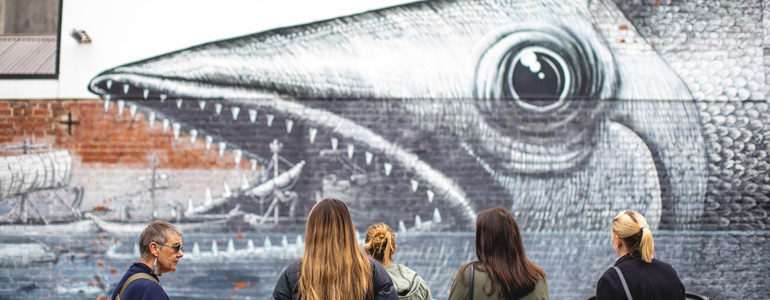
Seasonality
The other major inhibitor to profitability in the industry is seasonality. This has been a long-standing issue and is one area where support and direction from government can enable greater good outcomes. As a generalisation, tourism businesses have traditionally only made a profit in 3 to 4 months of the year. This has a significant impact on employment and all aspects of businesses’ ability to invest in non-financial wellbeings. It is simply wasteful. We are confident there will be a net-positive return on investment for the Government by supporting the seasonality recommendations in this report.
Other government intervention
There are some areas of the industry where market failures require government intervention. Because the industry is woven into so many aspects of society, and because it is so fragmented, we lack cohesive direction and leadership across central and local government, as well as, arguably, within the private sector. The industry needs a formal public/private leadership body and an in-depth review of local and district tourism leadership structures.
This level of leadership, combined with a new legislative framework for destination management, will enable more deliberate planning which can underpin the industry’s future success. Destination planning for local areas, districts and across different regions to align with visitor journeys must be a priority. Current approaches and boundaries have, in some instances, resulted in patch protection and inter-regional competition. The status quo needs to be challenged to enable better outcomes for communities and customers. The integration of visitor economy planning in local long-term plans and connecting those to a national planning framework is vital. It is also critical for these destination plans to be co-created with communities and to take a long-term view aligned with regenerative outcomes. To develop these plans properly will require funding support and they will need to be reviewed regularly.
To enable these new ways of operating at the local level, and to improve infrastructure, we need to rethink how we collaborate at scale (public/private and not-for-profit working together) for infrastructure investment, environmental improvement and hero product development. To achieve this, we need to leverage public capital and longer government investment horizons under a new framework that is specifically connected to achieving returns across all 4 wellbeings.
Good information and data will also be a critical piece of the puzzle. We need to radically improve our approach to capturing, managing and using good data to inform decision-making and investment. Comprehensive and useful data that makes the best use of available technology can help both public and private sectors to work more effectively in addressing challenges and capture opportunities. Congested locations, dispersal and freedom camping issues can all be addressed simply with data and technology. We see this sort of open data and information management system squarely as a matter of public benefit, so it is appropriate for it to be funded centrally. However, we also believe there is a clear return on investment for the Government that will enable social, cultural, environmental and economic wellbeing benefits.
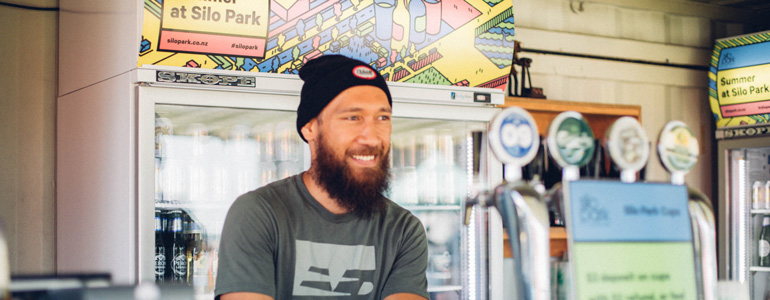
A systemic approach to funding
How we fund future development is one of the most important discussions. For the medium term, we have proposed a set of core principles* that should apply to any new funding mechanism; however, to start with, we need to have a clear understanding of the current situation. We have an infrastructure gap in Aotearoa New Zealand which needs to be addressed.
The reality is that the Government cannot support all aspects of improvement without receiving more revenue in return – the books need to be balanced. Visitors do need to pay more, at various points in the customer journey. While there is more work to be done in assessing estimated levels of investment and returns, we believe our recommended approach will more than pay for itself over time – and not just financially. By taking a systemic lens, the visitor economy will deliver benefits across all four wellbeings while addressing issues of productivity and efficient use of capital. At the heart of this solution is removing waste and inefficient pricing, seeding long-term profitable projects and managing the system levers more effectively.
Visitors and New Zealand's brand
When we enable this collective system approach for our visitor industry, we will attract the kind of visitors and interactions that match our own values and the aspirations for Aotearoa New Zealand. The infrastructure we enable, the products we offer, the brand we promote and – most importantly – the way we interact with each other will drive the type of non-local visitors we attract, and how we interact with them. At the heart of every visitor experience is an interaction with people: local, national, short haul or long haul. This evolution is what we have called Aotearoa Whakapapa.
The Future States and recommendations which follow deliver to this narrative and are summarised in the graphic below.
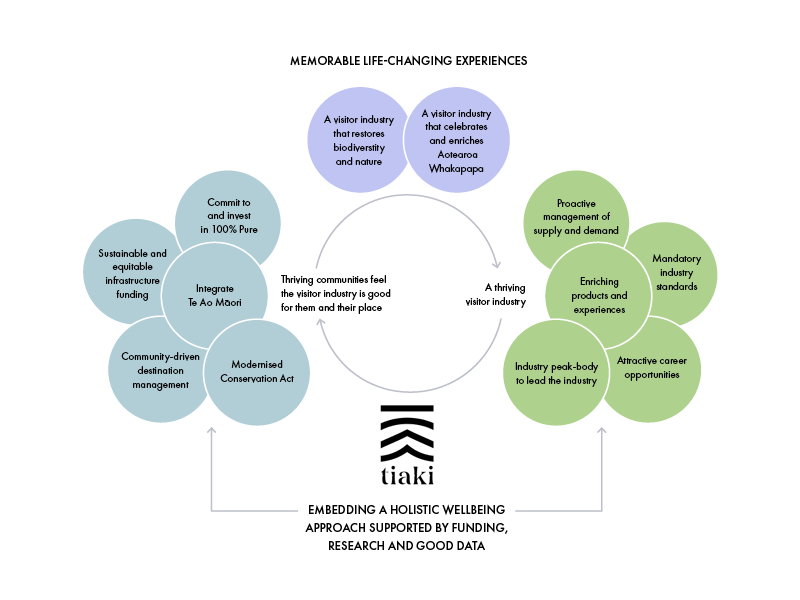
Text description of diagram

